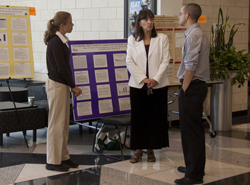The Freshmen 15 - It's All About Prevention
JMU News
In the middle of the 2009-2010 academic year, freshmen received an e-mail from Dr. Melissa Rittenhouse and Alumni Emily Brown, asking the students to participate in a survey about their perceptions of the Freshmen 15. The 61 students that responded and participated in the survey found themselves in a very enlightening situation. Although there is little research to support that the Freshmen 15 actually exists, the study conducted by Rittenhouse and Brown found that midway through the year, freshmen had gained about 7.7 pounds-they were right on track to gain the fifteen pounds. The purpose of this study was to identify student perception of college freshmen on weight gain, not to encourage freshmen to go on diets. "We didn't perform this study to encourage weight loss, we just wanted to prevent weight gain," stated Rittenhouse.
Rittenhouse first acknowledged the need for this study when she realized the increasing rate of obesity in adolescents. As stated on the poster for the study: "29.9% of college students are overweight or obese, according to self-reported weight/height measures." So, Rittenhouse set out to determine the best way to educate students on their eating habits and make them more aware of what they were putting into their bodies.
To accomplish this study, Rittenhouse divided participants up into one of four groups: students that received information through text messages, students that received information through e-mail, students that attended lecture groups, and students that didn't receive any type of communication, called the control group. By the end of the study, Rittenhouse and her team found the results they expected. "Those who tried to prevent the weight gain did prevent it," said Rittenhouse, "the key was exercise, and those who exercised seemed to keep the weight off easier than those who didn't." Another key factor was the awareness of the quantity of food students were eating. Students who practiced portion control and had a regular exercise routine did the best at keeping the weight off.
After all the results were collected and presented, Rittenhouse, Dr. Patricia Brevard and student Ashley Luebbers decided to conduct a follow-up questionnaire. Another e-mail was sent out to the same class that had been asked to participate in the survey the year before. Surprisingly, about 689 students participated in this follow-up. Students gave very useful information, such as why they didn't participate in the previous study, what information they found useful, and what could be done to improve the nutritional education of the students on campus.
Although this survey included students who did and did not participate in the original survey, there was no large difference found between the groups. Forty-four percent of the students that participated in the study found themselves more aware of their eating habits. Students remembered some key facts from the study, such as the benefits of walking, the importance of portion control, and the fun fact that 3500 calories is equivalent to one pound. These results were appreciated by Rittenhouse and Luebbers; both were glad to have educated some of the campus with these nutrition facts.
Besides the pride of a job well done, Luebbers also received recognition for her hard work on this study. She won an award from the Virginia Dietetic Association for best poster.
Although much work has been accomplished, this is only the first step. Rittenhouse, along with many others, hopes to implement these findings to help educate the student body in ways they would appreciate.
Rittenhouse discovered from the follow-up that students wanted to receive this information about healthy eating on campus through e-mails or displays in dining halls. For eight weeks, displays will be found in the E-Hall dining hall, featuring six weeks of information about different nutrients, with the first and last week reserved for testing. "We want to find the best way to modify behavior, and to do that, we need to find ways that will keep students interested."

